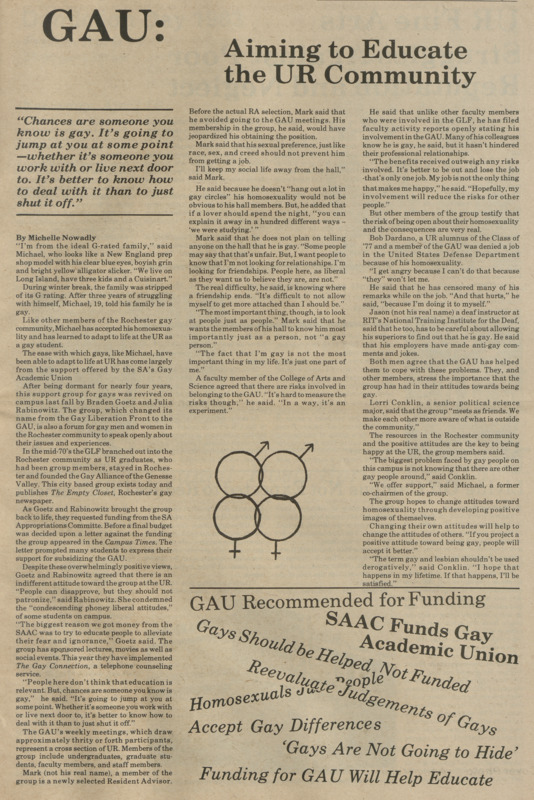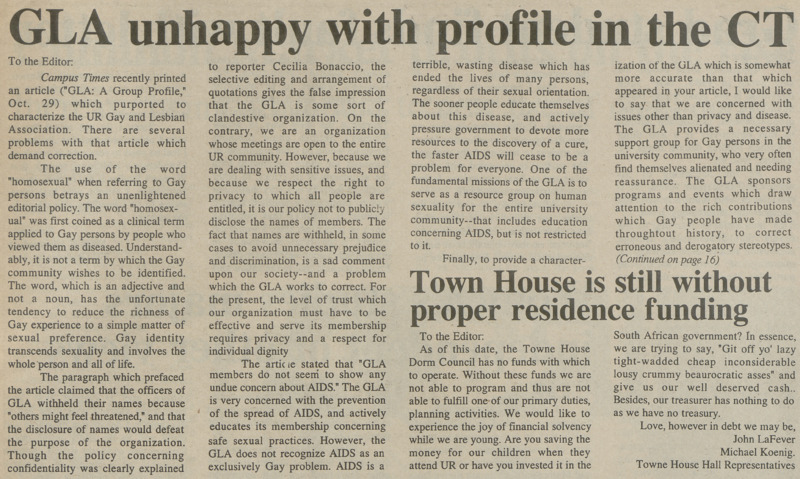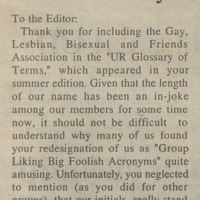1980s
Gay Academic Union
In the fall of 1981 a new student group is formed, the Gay Academic Union (GAU). On October 19th, 1981 a letter was printed in the Campus Times introducing the newly formed Gay Academic Union. It seems that briefly the name “People’s Union” was considered, which is printed in the SA club directory for 81-82 but doesn’t show up in advertisements or articles. With the absence of a current gay group, students hoped to fill the much-needed gap to support students and foster community. The Gay Academic Union would shift focus from the politically oriented Gay Liberation Front to more student-oriented resources. A letter from the Gay Academic Union, published in the November 12, 1981 issue of the Campus Times. The letter, titled "GAU Holds Meeting," reads:
“Many people have contacted us to express their feelings that the formation of our group is long overdue. With the decline ofthe Gay Liberation Front in the mid-seventies (last active at the UR in 1979-80) there is a real need for an organization to take its place. — Our approach, however, is different. We have renamed our organization in order to show that we are not primarily political. Our main concern is the well-being of Gay people at the UR, and our goal the establishment of a sense of community here, such as exists at virtually all other Universitites and the majority of colleges in the US.”
The GAU went on to host film screenings, lectures, weekly meetings, dances, and more. Members brought back the short-lived Gay Liberation Front radio show ‘Gay Waves’ for a few more iterations. A key directive of the Gay Academic Union was the creation and maintenance of a hotline to take calls as a mode of support. This hotline, called the Gay Connection was funded by the Student Association.
In the Fall of 1981 attendance at weekly meetings was high, roughly 25-30, but the spring semester dwindled and no longer held consistent weekly meetings due to low turnout. [20] The group set about efforts to increase interest, fight discrimination, and collaborate with gay faculty.
The following fall, 1982, the group attempted to get a budget funded by the Student Association. The funding of a gay group spurred some debates within Campus Times letters to the editor with students airing their support or opposition. [21] The Students' Association Appropriations Committee (SAAC), after a vote, decided to fund the Gay Academic Union resulting in more strong letters showing support and happiness, reinforcing the importance of the group.
The key goal of the Gay Academic Union was simple: to educate the campus community about sexuality. Articles appeared in the Campus Times highlighting the GAU and its goals. This full-page feature from April 14, 1983, shows a glimpse of gay life on campus as the GAU was gaining momentum.
"After being dormant for nearly four years, this support group for gays was revived on campus last fall by Braden Goetz and Julia Rabinowitz. The group, which changed its name from the Gay Liberation Front to the GAU, is also a forum for gay men and women in the Rochester community to speak openly about their issues and experiences."
The re-emergence of a gay group on campus would increase visibility and aid in student life on campus. Despite hurdles, the club's revival was successfully reaching students. Meetings at this time were seeing 30 to 40 attendees. Not only could this be beneficial to the current students in need of support, but it was also setting a precedent to continue forward as a stronger group backed by the Student Association. This could in turn affect future attitudes and perceptions of gay people, making the community a safer environment for gay students.
"The group hopes to change attitudes toward homosexuality through developing positive images of themselves. Changing their own attitudes will help to change the attitudes of others. 'If you project a positive attitude toward being gay, people will accept it better.'.. 'The term gay and lesbian shouldn’t be used derogatively,' said Conklin. 'I hope that happens in my lifetime. It that happens, I'll be satisfied.'
By taking on the feat to educate the campus community, the GAU was successfully filling the shoes of its predecessor the Gay Liberation Front while taking strides to fit the group to the needs of students.
Though the Gay Academic Union was short-lived in name it managed to reignite the passion and momentum of the group to continue being an active presence on campus. In 1983, the campus group once again underwent a name change. The Gay Academic Union becomes the Gay and Lesbian Association (GLA) in the fall of 1983.
Gay and Lesbian Association
A big effort spearheaded by this group was the Gay Connection, a hotline for students specifically intended for issues related to sexuality. Started in February of 1983 under the Gay Academic Union, the hotline provided anonymous services and information about gay and lesbian issues which could ease the fear of reaching out. Members of the GLA trained and acted as listeners to help those who called, often people in the process of coming out or realizing their identities. [22] There were frequent advertisements for the hotline from the early 1980s into the mid-1990s. The name would eventually expand to include lesbians as well as gays, relabeled as the Gay/Lesbian Connection (G.L.C.).
To increase awareness about the gay community, there were some interviews and articles published in the Campus Times showing the opportunities that the Gay and Lesbian Association was cultivating. These features also depicted the campus attitudes towards the group. A profile on the GLA, printed on October 29, 1987, attempted to show the purpose and history of the group. [23] Many dates and details are incorrect. It misrepresented the group as a whole, so much that the president of GLA wrote soon after to correct the issues of spreading these misconceptions. This ordeal reflects the commonality of misconceptions as well as the importance of correcting and educating on gay issues.
Films
The Cinema Group held a film series in the fall of 1981 titled “Cinematic Sexuality Series” which played movies that touched on various aspects of sexuality. The topics covered in the film series were sexual stereotypes, female relationships, male relationships, casual sex, dilemmas in sex, and prurient pleasures. A few of the shown films are now associated with homosexuality whether explicitly or implied. The films shown were: Butch Cassidy and the Sundance Kid, Turning Point, Midnight Cowboy, Carnal Knowledge, Get Out Your Handkerchiefs and The Devil in Miss Jones. The 1980s saw an increase in gay characters and stories in cinema. This would eventually lead to local film festivals dedicated to sexuality and gender identity, but in the meantime, these films caught the attention of students writing for the Campus Times.
The Campus Times featured frequent columns filled with film reviews. One student, Gary Kramer, wrote countless reviews in the late 1980s. A number of these films dealt with gay themes and storylines. As a film and English double major he expressed himself and his love for films in these columns and features. Today Kramer, a professional writer and film critic, has kept up this passion for reviewing films with LGBT representation writing for the Philadelphia Gay News among other publications.[24]
A few examples of his reviews show the representation available at the time he attended the University of Rochester.
- Beyond Therapy (1987): A Romantic Comedy with a bisexual lead character.[25]
- Maurice (1987): A film adaptation of Maurice by E.M. Forster. The film is a romantic drama about homosexuality in the early 20th century. [26]
- Kramer refers to the film as a "brilliant mistake."
- This harsh review received backlash from another student who liked the film. The review and its response show differing perceptions of the representation at hand. [27]
- Kramer refers to the film as a "brilliant mistake."
- Prick Up Your Ears (1987): A Homosexual love affair set in England at a time when homosexuality was a crime. [28]
- Apartment Zero (1988): A sexual and political thriller with homosexual angst. [29]
Gay, Lesbian, Bisexual and Friends Association
The end of the decade saw one more name change for the group. In April of 1989, the group started shifting towards an expanded name, the Gay, Lesbian, Bisexual and Friends Association (GLBFA) which would include more identities. This happened around the same time that the group began to sponsor “Beginning Here,” a support group for lesbian and bisexual women. This marked a shift towards expansive inclusion to make sure that all factions of the community were getting what they needed out of a campus group.
In the fall of 1990, the group clarifies the need for an inclusive name and the reason they had added more letters to their acronym. The Summer 1990 edition of the Campus Times listed the GLBFA in a humor glossary of the campus, writing the definition as “Group Liking Big Foolish Acronyms.” While only a joke, it risked that the group not be taken seriously. The GLBFA publishes a letter speaking on the importance of including explicit mentions of homosexuality to avoid the constant censorship of gay individuals and gay history. [30] This clarifies the importance of the group itself as well as its now longer name. This letter of clarification and defense is an important document to look back on to see the values and opinions of this iteration of the group. It became part of the often silenced gay history that the group wished to preserve.





